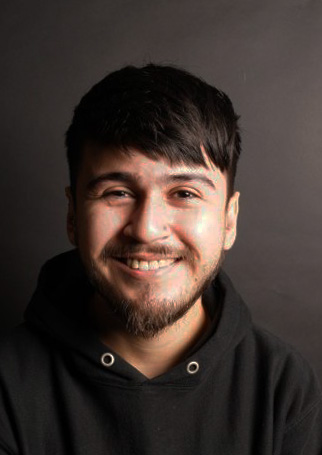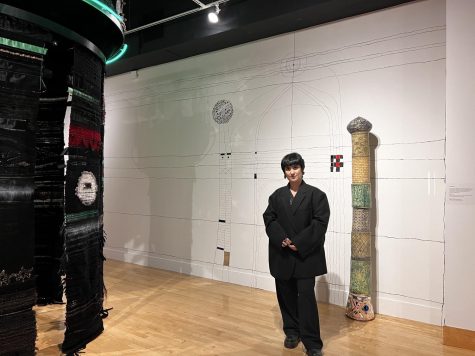
Fine Arts Gallery premieres MFA thesis show “Other Structures”
Graduate students of SF State’s Master of Fine Arts program present their final works of the semester during opening reception.
May 1, 2023
SF State’s Fine Arts Gallery officially premiered its MFA thesis show exhibit, “Other Structures” on Friday. During its opening reception the exhibit drew a large number of guests who arrived to show support for the graduating artists.
In order to receive a master’s from the School of Art, graduate students are required to participate in a thesis exhibit and produce a written thesis that serves to show their progress throughout their time at SF State.
Students from professor and Gallery Curator Kevin B. Chen’s exhibit design class and artists whose work was on display were present hours before doors opened on Friday, putting the finishing touches on their exhibits in preparation for the opening reception that was rapidly approaching.
Like with other exhibits shown in the Fine Arts Gallery, Chen’s students had their hand in the design and construction of the exhibits. That being said, a team of graphic design students, along with School of Design Professor Joshua Singer, worked with Gallery Director Sharon Bliss, Chen and all artists featured in the exhibit to best figure out how to exemplify the event. According to Bliss, the title “Other Structures” came about as a result of the design department’s work with Fine Arts.
“And so months ago, all of us on Zoom, the seven artists, Kevin and me and Joshua, and a team of, I think, five students from that class sat down and just really talked about what’s this gonna look like…and then they came up with “Other Structures” because they [the artists] all are sort of building in their own way,” Bliss said. “And so it makes your brain think a little bit more about what the second word is with the way that the tears in the text are. And I just think it’s great.”
“Other Structures” is a predominantly immersive experience, with almost every piece in the gallery offering some sort of interactive element attendees can participate in. Stationed directly by the desk to the right of the entrance stands “Memory Machine” — a coin fed vending machine that provides visitors with their very own “memory fragment” for the cost of $1.
According to the “Other Structures” catalog, which includes essays written by Dionne Lee on the artwork presented in the gallery, the machine is much more interesting than its traditional candy-filled counterparts.
“A toy dispenser becomes a body–a stomach holding nervous energy, a brain filled with thoughts. Viewers are invited to empty the vessel by purchasing these keepsakes. Nothern’s Memory Machine is both a container and protector of these memories, that are at the same time asking to be set free.”
The memory fragments the machine gives outcome in the form of glass charms, which are accompanied by a note detailing a specific memory from Mel Nothern, the artist behind the machine and other works in the gallery. During the first hour of the gallery’s opening, the machine proved itself as a popular first stop for attendees.
Following the gallery’s flow in a counterclockwise direction, Owen Takabayashi’s installations are usually next to catch people’s eye. On several tables borrowed from the sculpture classes that take place downstairs, Takabayashi shows off seemingly random bits and pieces of miscellaneous items that might make some wonder exactly what they’re looking at — which is exactly the point. His work aims to push viewers to reexamine their relationships with the seemingly mundane and discarded materials we come into contact with so often.
According to Takabayshi, he wanted to keep things “dense” by providing a lot of information to be interpreted in his installation.

Continuing on, attendees are able to experience the works and messages of all seven artists in the gallery seamlessly before ending in the farthest corner of the space, where the walls have been written on and a large black installation stands ominously.
Sanaz Safanasab’s work aims to examine feelings of mourning and frustration that come about through the exploration of Iran under the Islamic Republic and her own trials and tribulations. The decorated walls in the corner of the gallery, covered in hand-drawn sketches of Islamic mosques, are meant to be temporal — after the show, they’re gone forever.
“Hejleh,” the large black tent installation near the rest of her work, touches on a similar subject — displacement and the nomadic lifestyle — and was handwoven to include some of Safanasab’s own hair as an act of solidarity for victims of oppression, namely Mahsa Amini.
“I was thinking about death, black color,” Safanasab said, commenting on the creation process of “Hejleh.” “Before my father passed away I was really into the idea of opacity, the right to be opaque as an immigrant and non-white person… When my father passed away I was thinking of mourning myself, so it’s got a personal aspect to it. Mahsa Amini was murdered, so I was again thinking about mourning as a personal journey of life. Because life and death is one thing. And a collective way of mourning all together, I found this….the comuncal presence of death, it’s really important and unique to my culture.”
The opening reception of “Other Structures” comes as other art graduate programs in the Bay Area also begin to show off student work. According to Bliss, the MFA exhibit presents a golden opportunity for artists to get noticed by others in the area. Berkeley and Stanford, among many other universities, are set to premiere their MFA exhibits starting mid-May.
Located in the Fine Arts Gallery Room 238, “Other Structures” is open to visitors April 28 to May 18, from 12 p.m. to 4 p.m.


